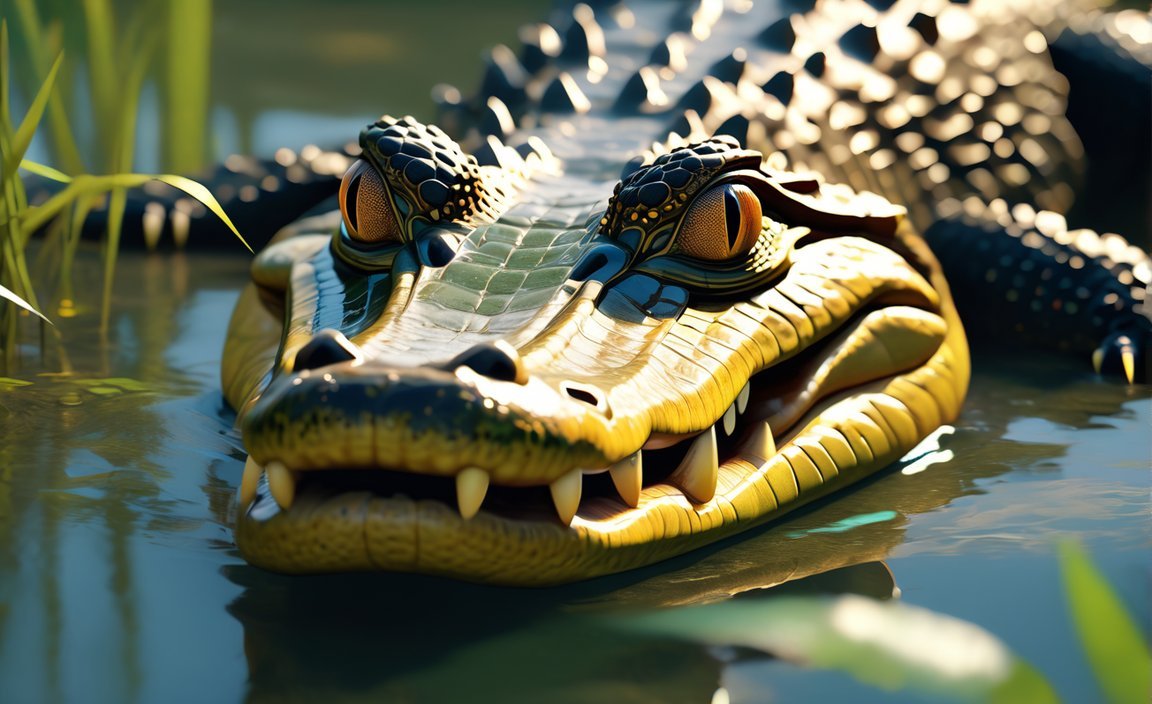Regarding reptile marvels, few species could equal the mysterious alligator. And scales are the fundamental characteristic of its amazing physiology. But what precisely are the mysteries buried under these finely crafted plates? Come see the amazing wonders of reptile skin as we embark on an interactive trip into the world of alligator scales. From their distinctive patterns to their vital part in survival, be ready to set off an amazing journey over the subtleties of one of nature’s most beautiful works.
Key Learnings:
- American alligators have both scales and skin; their tummies and chins are rather smooth while their backs feature thick, scaly gnarled skin.
- On the undersides of their bodies, alligators’ delicate and flexible scales—known as scutes—have snakelike qualities. Their necks, tails, and backs, though, are covered in tough, armor-like scales.
- Comprising tiny scales, alligators have between 80 to 100 scutes on their back. Without being coupled with the skeleton, their scales on their belly, legs, and tail also give flexibility.
- Alligators’ epidermal scutes are made of oblong horny scales set in transverse rows for defense.
- Unlike snake skin, which is lost whole, alligator skin molts in portions as the animal matures.
Do Alligators Have Scales?
One amazing characteristic of alligators, the ancient reptiles that have prowled the planet for millions of years, distinguishes them from other animals: scales. These scales not only give their appearance a distinctive look but also are rather important for survival and adaptability. We shall explore the complex world of alligator scales in this essay, including their composition, purpose, and part in guaranteeing the general well-being of the alligator.
Various Types of Alligator Scales
Unlike the flaky scales seen in fish, alligators have soft, flexible scales mixed with stiff, armor-like scales called scutes. These scutes cover their backs, tails, and necks, therefore offering a strong barrier against possible predators and hostile surroundings. Alligator scales are not permanently fastened to their body as a suit of armor would be. Rather, they resemble a protective shell that develops alongside the alligator and sheds as the animal becomes bigger.
Softer scales abound on the undersides of the alligator’s body, including their stomachs, legs, and tail. These scales provide the alligator the flexibility required for effective mobility on land and in water, and they feel substantially like snakeskin. The alligator’s special mix of soft scales and scutes guarantees enough protection and best mobility.
The Value and Function of Alligator Scales
Beyond only appearance, alligator scales have a variety of uses. These scales first and most importantly protect the alligator’s sensitive skin and underlying tissues. The hard and bony makeup of the scutes protects the internal organs of the alligator from many environmental risks and possible predators. While providing further protection, the delicate scales on the undersides of the body let for small motions necessary for swimming and nimble moves.
Furthermore, alligator scale arrangement and construction help to preserve their body temperature. By helping to preserve thermal energy and decrease heat loss, these scales enable alligators to live in a variety of habitats and climates. This thermoregulatory ability is especially important in cooler months or when alligators come out of hibernation so they may control their body temperature and remain active.
The Marvel of Alligator Scale Patterns
The patterns of alligator scales hold among their most fascinating features. Every alligator has between 80 and 100 scutes on their back, each made of numerous tiny scales. The way these scales are arranged creates almost like a fingerprint-style captivating pattern unique to every individual alligator. These unique scale patterns help the alligator to be visually appealing and act as markers for individual recognition and population studies that researchers may employ.
Moreover, alligator scales provide understanding of their development and age. Like counting growth rings on tree trunks, scientists can approximate an alligator’s age by looking at growth rings on scales. This important data helps one understand population dynamics, investigate growth rates, and evaluate the general state of alligator populations.
Alligators have, at last, a complex and amazing range of scales that support their survival and adaptation. Combining soft and robust constructions, these scales provide protection, improve maneuverability, and help thermoregulation. Unique to every individual, the scale patterns of alligators act as markers and offer important age and growth-related data. Emphasizing the amazing adaptation and complexity of these ancient reptiles, alligator scales really reflect the wonders of reptile skin. Thus, the next time you come upon an alligator, stop to admire the beauty and practical importance of their amazing scales.
In the vast taiga biome, the intricate food chains play a crucial role in maintaining the delicate balance of this ecosystem. Explore the fascinating world of food chains in the Taiga biome here.
The detrimental effects of water pollution on aquatic life are truly astonishing. Discover how water pollution affects the survival of various species and their delicate ecosystems here.
Did you know that there is a non-metal element with surprising metallic properties? Uncover the mysteries of this intriguing element and its unique characteristics here.
Gorillas, our closest relatives, possess incredible levels of intelligence. Dive into the captivating realm of gorilla intelligence and discover the remarkable abilities of these majestic creatures here.
Types of Scales Found On Alligators and Their Distribution On the Body
These magnificent old reptiles, alligators, have distinctive scale patterns that not only help to defend them but also offer vital information about their environment. Let’s investigate the several forms and distribution on the body of the interesting world of alligator scales.
Unravelling the Scale Mystery
Covering their body, both hard and soft scales of alligators serve a particular function. Protecting the alligator’s back, neck, and tail is mostly dependent on the hard scales—technically called scutes. These scutes create a smooth, strong layer of protection against possible hazards, resembling a hardened armor.
Conversely, soft, flexible scales abound on the belly, legs, and softer sections of the tail of the alligator. Unlike the scutes, these scales provide the alligator’s movement and interactions with its surroundings a more flexible and pleasant arrangement.
A Juxtaposed Architecture
Alligator scales are unique in their arrangement unlike overlapping fish scales. An alligator’s body has scales arranged in a juxtaposition pattern, close to one another. This closely packed arrangement guarantees no gaps or exposed parts, therefore providing optimal protection for the delicate skin and underlying tissues of the alligator.
Comprehending Alligator Molting
Growing alligators need their scutes and other scales to fit their growing size. As with snakes, alligators moult their skin in patches rather than shedding it all at once. The alligator loses old skin during the molting process while fresh scales start to replace the ones she shed. A special adaptation allowing the alligator’s scales to constantly change and extend as the individual grows is patch-wise molting.
Alligator Scales: Their Special Function
Alligator scales have uses other than only defense. By lowering heat loss and preserving thermal energy, they help the alligator’s body temperature to be regulated. Alligators must keep ideal body temperature for their metabolic activities, hence this thermoregulatory ability is absolutely vital.
Furthermore, much as a human fingerprint, an alligator’s scale patterns are unique to every person. By means of population studies and identification, these unique patterns help researchers to monitor and track alligator numbers in their natural settings. Moreover, the development rings seen on alligator scales can offer important age-related information, therefore helping us to better grasp their life cycle and lifespan.
Key Learnings:
- Alligators have soft scales and hard scutes on their bodies that offer flexibility and protection.
- Whereas softer scales are present on the belly, legs, and tail, scutes guard the back, neck, and tail.
- By means of a contrasting pattern, alligator scales guarantee full coverage and improve their defense mechanism.
- Molting happens in patches, allowing new scales to develop and fit the expansion of the alligator.
- Alligator scales assist control body temperature by means of thermoregulation, therefore supporting metabolic processes.
- Population research and identification benefit from the distinct scale patterns seen in alligators.
- On alligator scales, growth rings offer information on an individual’s age and life cycle.
Sources:
– reptilesblog.com/do-alligators-have-scales
– wildlifefaq.com/alligators-scales-skin
Throughout their evolutionary journey, the remarkable alligator scales have adapted to meet the challenges of their environment, making them a subject of admiration and scientific intrigue. These scales truly embody the marvels of reptilian skin, showcasing nature’s ingenuity and the captivating diversity of our planet’s wildlife.
Adaptations of Alligator Scales for Survival and Protection
Fascinating features of reptile anatomy, alligator scales provide special adaptations that help them survive and guard their ecological habitats. These scales help in thermoregulation and stop water loss, among other things. Let’s investigate the amazing adaptations of alligator scales and their part in guaranteeing the survival of these extinct species.
Protection against water loss and waterproofing
Particularly the bony scales known as “scutes”, alligator skin acts as a crucial barrier preventing water loss. Together with the softer, flexible scales present on their belly, legs, and tail, these scutes cover completely to protect from the weather. Shielding the alligator’s tail, back, and neck from any hazards and injuries, the scutes (“American Alligator | National Wildlife F…”, n.d.) Particularly in warmer regions (” Skin Prevents Water Loss — Biological Strat…”, n.d.), the scales are also rather important for preserving waterproofing qualities, stopping moisture loss, and making sure the alligator is hydrated.
Encouraging Action in Water
Well-adapted to their aquatic environment, alligators’ scales help them to have remarkable swimming ability. Apart from their long, strong tails and webbed feet, the way their scales are designed and flexible helps them to move effectively across water (“Do Alligators Have Scales Or Skin? Christy,” n.d.). These traits taken together let alligators quickly negotiate their habitats, whether they are hunting or avoiding possible predators.
Sun-basking and thermoregulation
Cold-blooded creatures such as alligators depend on thermoregulation, hence their scales help to preserve their body temperature. These reptiles control heat loss and store thermal energy by means of their scales. With its dark-colored skin to absorb heat and increase their body temperature (“Do Alligators Have Scales Or Skin? Christy,” n.d.), alligators can lounge in the sun. They also can burrow tunnels in mud to trap heat, so enabling their adaptation to different surrounding temperatures.
Respiration Underwater
Special characteristics in alligators enable them to hold their breath for long lengths of time. Using oxygen slowly, they can lower their heart rates to as few as two or three beats per minute (“How Long Can an Alligator Hold Its Breath? And Other Questions,” n.d.). Their amazing capacity to adapt to their surroundings allows them to thrive underwater either hunting or avoiding predators.
Key Learnings: Because they prevent water loss and offer waterproofing qualities, alligator scales—especially the bony scutes—are absolutely vital for their existence. Along with their strong tails and webbed feet, alligator scales’ flexibility helps them to move effectively in water. Using their scales for thermoregulation—basking in the sun and trapping heat—alligators help to keep their body temperature. These reptiles have special characteristics that let them survive underwater either hunting or avoiding predators by holding their breath for long stretches of time.
Comparisons between Alligator Scales and Those of Other Reptiles
The minute features of reptile species captivate me as a seasoned nature lover and wildlife researcher with a lot of herpetic experience. Particularly alligators fascinate me with their unusual scale patterns and part in guaranteeing their existence. The wonders of alligator scales will be discussed in this article together with a comparison to other reptiles, therefore clarifying the interesting traits that define these amazing animals as a miracle of evolution.
Alligator Scales: Armor & Protection Form of Armor
Sources such The Reptile Room and Reptile City indicate that alligators and crocodiles have scales covering their whole bodies. These scales shield them from predators and other hazards like armor would. Combining soft, flexible scales with stiff, armor-like scales known as scutes, alligators have
Although the undersides of alligators feature whiter, smoother scales akin to those of a snake, their back scales are different. Comparatively to the scales on their hips, these hard bony plates—known as scutes—can be broader and more decorative. The scutes provide protection to their delicate skin and underlying tissues, assuring the alligator’s safety in its natural habitat.
Special Adaptations of Alligator Scales
Beyond only defense, alligator scales have several uses. Crucially important for thermoregulation, they enable the alligator to keep its body temperature. These sun-loving reptiles are well-known for basking; the scales help to trap heat, therefore preserving thermal energy. With their amazing scale patterns, alligators provide a contrasting pattern that offers whole coverage and improved protection.
An other amazing adaptation is the shedding and expansion of alligator scales. Alligators shed their scales and replace them over time, much as many reptiles do. Though the particular mechanism is not stated in the given context, this shedding guarantees the continuous functionality of scales by allowing for growth and replacement of them, therefore safeguarding the body of the alligator.
Alligator Scales vs Other Reptiles
When one compares alligator scales to those of other reptiles, some fascinating parallels and contrasts show themselves. Although alligators have both soft scales and hard scutes on their body, other reptiles could have different texture and composition of their scales.
For example, unlike the separate scutes seen on alligators, snakes usually have smooth, overlapping scales. Though their scales may not be as stiff or protective as those of alligators, lizards exhibit different scale patterns. Understanding these variances helps us to value the complexity and adaptability of reptile skin more.
Key Learnings: Especially the bony scutes, alligator scales offer defense against water loss and other outside hazards. Along with their strong tails and webbed feet, alligator scales’ flexibility helps them to move effectively in water. Using their scales for thermoregulation—basking in the sun and trapping heat—alligators help to preserve their body temperature. Unique characteristics enable alligators to survive underwater either hunting or avoiding predators by allowing them to hold their breath for long lengths of time.
Sources:
1. The Reptile Room: “Do Crocodiles and Alligators Have Scales?”
2. Reptile City: “Everything You Need To Know About Crocodile Scales”

FAQ
What materials make up alligator scales?
Made of hardy keratin patches, alligator scales—also known as scutes—are unlike usual reptile scales. These bony scales shield the body of the alligator.
An alligator has how many scales? Q2
On its rear, an adult alligator possesses between eighty to one hundred scutes, each composed of numerous smaller scales. With scales on their belly, legs, and tail as well, alligators have approximately 1,000 total scales.
Q3: Do alligators slink like snakes?
A3: Unlike that of a snake, alligator skin does not shed in one piece. Rather, as they grow, alligators moul their skin in patches, losing their old skin and developing new scales.
Q4: Why would one use alligator scales?
Alligator scales act as a protective armor, giving the alligator’s body a smooth, hardened covering. They preserve waterproofing, guard against water loss, and help thermoregulation.
Q5: In what ways could alligator scales facilitate water movement?
Along with their strong tails and webbed feet, alligator scales let alligators move in water. Particularly on the back, tail, and throat, the scales simplify protection and lower drag thereby enabling effective swimming and movement.
q















